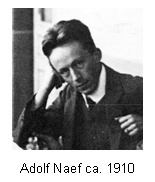Name Adolf Naef | Died May 11, 1949 | |
 | ||
Books Fossil Dibranchiate Cephalopods: A Paleozoological Monograph | ||
Adolf Naef (1 May 1883 - 11 May 1949) was a Swiss zoologist and palaeontologist who worked on cephalopods and systematics.
Adolf Naef studied at the University of Zurich under the guidance of Arnold Lang (1855—1914), a former Professor of Jena University and close friend of Ernst Haeckel. Naef visited and worked in Anton Dorn’s Zoological Station in Naples, Italy in 1908, studying the squid Loligo vulgaris, the subject of his dissertation. Naef returned to the Naples Zoological Station in the mid-1920s to study cephalopods, publishing a two-part monograph in the Station’s Fauna und Flora des Golfes von Neapel und der Angrenzenden Meers-Abschitte (Fauna e Flora del Golfo di Napoli) series, which formed the basis for his two short but significant monographs on systematic theory. In 1922 he became Professor at the University of Zagreb, and in 1927 was Professor of Zoology at the University of Cairo. Naef died on 11 May 1949; few obituaries were published.
Naef’s studies were framed within Systematische Morphologie, the details of which he sketched out as early as 1913:
“Phylogenetic and natural systematics deal with the same factual material, and although each has different basic concepts, both disciplines can be united in a single concept because their objects are so similar. I have therefore proposed the name ‘systematic morphology’ for this concept … It is intended to show that there is an inner relationship between natural systematics and (comparative) morphology”
Naef’s concern was with the discovery of natural, as opposed to artificial classification, a problem examined in detail by A. P. de Candolle. Naef expressed it as so:
“For decades, phylogenetics lacked a valid methodological basis and developed on the decayed trunk of a withering tradition rooted in the idealistic morphology and the systematics of pre-Darwinian times. There was talk of systematic ‘tact’ and morphological ‘instinct’, terms which were felt rather than understood and consequently insufficient to form the frame of a science which required sound definitions and clearly formulated principles”.
And thus was born Systematische Morphologie, perhaps the beginnings of cladistics, in its most general form. Towards the end of his career, Naef published several detailed accounts of ‘Systematische Morphologie’, including a succinct summary in the widely read 2nd edition of the Handworterbuch der Naturwissenschaften.
